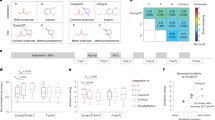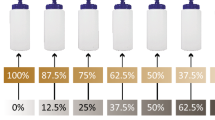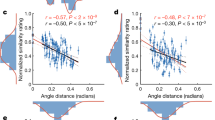Abstract
ACCORDING to Ruzicka's theory1 the character of an odoriferous substance is determined by its molecular shape, while the osmophoric group only causes variations in this character. The obvious importance of the spatial arrangement of the molecule of an odoriferous substance has caused the lock and key idea—established by Fischer in respect to the action of enzymes2—to be applied to the odoriferous substances and their perceptors3. Amoore4 suggested, with his stereochemical theory of olfaction, seven differently constructed perceptors in which those corresponding kinds of odoriferous substances all with a similar odoriferous character should fit the perceptor. Shallenberger and Acree5 maintained that two hydrogen-bond formers have to be present at a specific distance apart in a molecule if it is to have a sweet taste.
This is a preview of subscription content, access via your institution
Access options
Subscribe to this journal
Receive 51 print issues and online access
$199.00 per year
only $3.90 per issue
Buy this article
- Purchase on Springer Link
- Instant access to full article PDF
Prices may be subject to local taxes which are calculated during checkout
Similar content being viewed by others
References
Ruzicka, L., Chemiker Z., 44, 93, 129 (1920).
Fischer, E., Ber., Deutsch. Chem. Ges., 27, 2992 (1894).
Nerdel, F., and Spaeth, I., Angewandte Chemie, 63, 545 (1951).
Amoore, J. E., Nature, 212, 271 (1963).
Shallenberger, R. S., and Acree, T. E., Nature, 216, 480 (1967).
Briegleb, G., Elektronen-Donator-Aceptor-Komplexe (Springer, Berlin, 1961).
Bloom, G., Z. Zellforsch., 41, 89 (1954).
Brettschneider, H., Anatomischer Anzeiger, 105, 194 (1958).
Corey, R. B., and Pauling, L., Proc. Intern. Wool Textile Res. Conf., Australia 1955, B, 249.
Hensel, H., Allg. Sinnesphysiologie, 289 (Springer, Berlin, 1966).
Moncrieff, R. W., Manufacturing Chemist and Manufacturing Perfumer, 14, 175 (1943).
Author information
Authors and Affiliations
Rights and permissions
About this article
Cite this article
RANDEBROCK, R. Molecular Theory of Odour. Nature 219, 503–505 (1968). https://doi.org/10.1038/219503a0
Received:
Revised:
Issue Date:
DOI: https://doi.org/10.1038/219503a0
This article is cited by
-
Intermolecular basis of odour
Nature (1974)
Comments
By submitting a comment you agree to abide by our Terms and Community Guidelines. If you find something abusive or that does not comply with our terms or guidelines please flag it as inappropriate.



